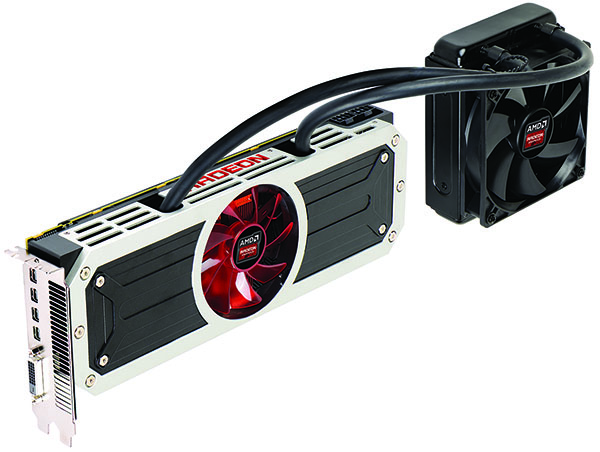Radeon R9 295X2 8 GB Review: Project Hydra Gets Liquid Cooling
“Do you have what it takes?” AMD asks, purportedly referring to the big budget and beefy power supply you need before buying its new Radeon R9 295X2. We benchmark the 500 W, dual-GPU beast against several other high-end configs before declaring a winner.
Radeon R9 295X2: AMD Did A Lot Of Things Right
As one of the most vocal critics of AMD’s past board designs, I’m satisfied with the choices it made in enabling two Hawaii GPUs on one graphics card.
Radeon HD 6990, Radeon HD 7970, Radeon HD 7990, Radeon R9 290—all of those products were remarkable in their own rights, boasting big specifications that should have rained fire down on the competition. But in every case, they were noisy, or hot, or unfriendly to the components around them. AMD simply wasn’t paying enough attention to design. Meanwhile, Nvidia followed up its plastic-enveloped GeForce GTX 680 with a series of metal-kissed, whisper-quiet reference-cooled boards that delivered performance and elegance.
Really, AMD’s Radeon R9 295X2 is the company’s first card—ever, I’d say—to emphasize the experience of owning high-end hardware. It takes two massive GPUs, runs them at a slightly higher clock rate than their single-processor implementation, cools them more effectively than the reference Radeon R9 290X, and makes less noise in the process. One Radeon R9 295X2 sips power compared to two Radeon R9 290Xes, based on measurements from our very expensive and very precise measurement equipment.
It’s not as polished as some of Nvidia’s cards. The closed-loop cooler can be unwieldy, and in addition to the rubber hoses, there are exposed fan leads you’ll want to tuck away. But AMD is using a cooler from Asetek bolted onto its own PCB, not an in-house thermal solution of its own to build around.
Still, I’ll take it. The metal shroud, back plate, and illuminated logo are all premium touches that transcend this company’s past efforts. Because the 295X2 employs a radiator and 120 mm fan designed to exhaust waste heat from your chassis, you aren’t forced to read my complaints about axial fans. Moreover, if you want to run two of them in a quad-GPU arrangement, power supply capacity and chassis selection should be your only two concerns.
Oh, and budget, of course. AMD tells us it plans to ask $1500 for the Radeon R9 295X2 when the card shows up for sale later in April. Just one should outperform Nvidia’s GeForce GTX Titan Z. But you’ll be able to buy two for the same price as the dual-GK110-based battleship. Clearly, that comparison leaves one super-dreadnought smoldering.
We’re smart enthusiasts, though. What about more economical card combinations?
Get Tom's Hardware's best news and in-depth reviews, straight to your inbox.
Let’s start with a look at AMD’s line-up. One Radeon R9 295X2 is almost exactly as fast as two 290Xes. The cheapest models are selling for somewhere between $570 and $600. For around $1200, then, you can have the same two Hawaii GPUs driving 4K resolutions in your ultra-high-end gaming PC. There’s just one problem: all of the partner boards worth buying employ axial fans that fill your case full of Radeon jetwash. Two 290Xes set up quite the cooling conundrum, particularly if you’re trying to overclock your CPU as well. Power users married to the idea of AMD graphics are better off paying the $300 premium for closed-loop liquid cooling, a dual-slot board, and a little extra prestige.
Drawing parallels to Nvidia is harder. The GeForce GTX 780 Ti is a great card, but it sells for $700. It’s good at 2560x1440. Logging memory use suggests that it comes awful close to running out of steam at 4K, though. We’re expecting 6 GB models for an extra $50 right around the time AMD says its new Radeon should start shipping, putting us at the same $1500 for a pair. Two Titan Blacks could be an alternative, though at $2200 combined, AMD’s card makes more sense.
In the end, Radeon R9 295X2 represents an important moment for AMD. Not only is this one product a compelling piece of hardware at a price that can be justified by flush gamers, but the company clearly listened to the feedback we hurled its way and built a board we’d be proud to own. AMD isn’t completely out of the woods, though. We have an estimated price and an estimated date for availability. The past several launches were peppered by misses on both fronts, and we’ve learned our lesson about recommending gear before you can buy it. We’re watching out for delivery on those promises, AMD.
Current page: Radeon R9 295X2: AMD Did A Lot Of Things Right
Prev Page Temperatures And Noise-
Marsian Gustrianda Many people doubt about Dual GPU Hawaii will be Blow Up. It seems AMD really do well job. Nice Looking CardReply -
ohim This card is like the Veyron of WV , show the world what you can do (R295x2) but you`ll still relay on the sales of your WV Golf for revenue (270x, 280x)Reply -
outlw6669 Impressive performance, temperatures and fairly low noise!Reply
I would prefer a bit lower price, but this looks like a great card for the gamer that has everything! -
gunfighter zeck the name Dreadnaught originated from Dread Nothing or, fear nothing.Reply
Boss ship. -
Maxamus456 Hope this price stays low and not get bloated from bit con miners like its predecessors.Reply -
blubbey So let me get this straight. It runs pretty cool, quiet, performs well and (for the moment) is able to play a good selection of games at 4k admirably and is priced competitively. Plus if you are going to drop a bit more on watercooling your GPUs (which is a possibility if you're spending $1200+) that gives this card even greater value. Nice work AMD.Reply -
marciocattini Wheres Tom's Hardware seal of approval? =( clearly this card diserves some love!Reply


